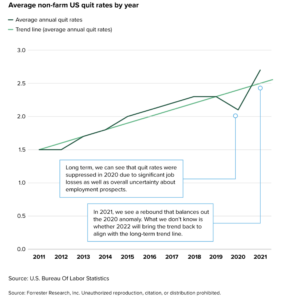The Great Resignation: The Reality Behind The Headlines
Far from a short-term talent crunch, the so-called “great resignation” has been 10 long years in the making. If you respond to it with short-term measures, you will miss the underlying drivers of today’s talent problems and leave yourself struggling to manage the future of work. In my new report, Unpacking The Hype About The Great Resignation, I look beyond today’s facile headlines to show how resignation rates have been climbing steadily since 2011 (see the figure from my report below).

While it’s true that there is a labor shortage — and nowhere is this felt more keenly than in industries such as leisure and hospitality and retail or for cross-industry technology roles — the demographic and cultural changes behind it won’t be easily solved by simply throwing signing bonuses at new talent. The pandemic accelerated the retirement of many boomer-generation workers, and many demographic groups have not returned to the levels of pre-pandemic workforce participation (which is not counted in unemployment rates) that existed in 2019. Meanwhile, younger workers are rethinking what it means to commit to a career, much less a single company. All of this is happening at a time when there are 4.6 million more job vacancies in the US than there are unemployed people. This all makes it a sellers’ market, where workers are “selling” their talent to eager “buyers” or employers who have to compete for their attention.
Your solution to this crunch is to compete on employee experience (EX). As I explain in my report, the short-term pain of the moment must be addressed with long-term EX practices that, let’s be frank, you needed to invest in anyway, as the pandemic made clear. Forrester clients can read the whole report to learn about five EX efforts they can emphasize now to come out of the current crunch with lasting advantages. These efforts including things such as addressing burnout as well as taking the long view that I have previously written about called the “no more jobs” model. This will take time, effort, and investment, all of which will pay off in more engaged employees operating at a higher level of productivity and with greater purpose.
_____
Katy Tynan, principal analyst on the “future of work” team, researches the intersections between leadership, organizational design, employee experience, and technology.
